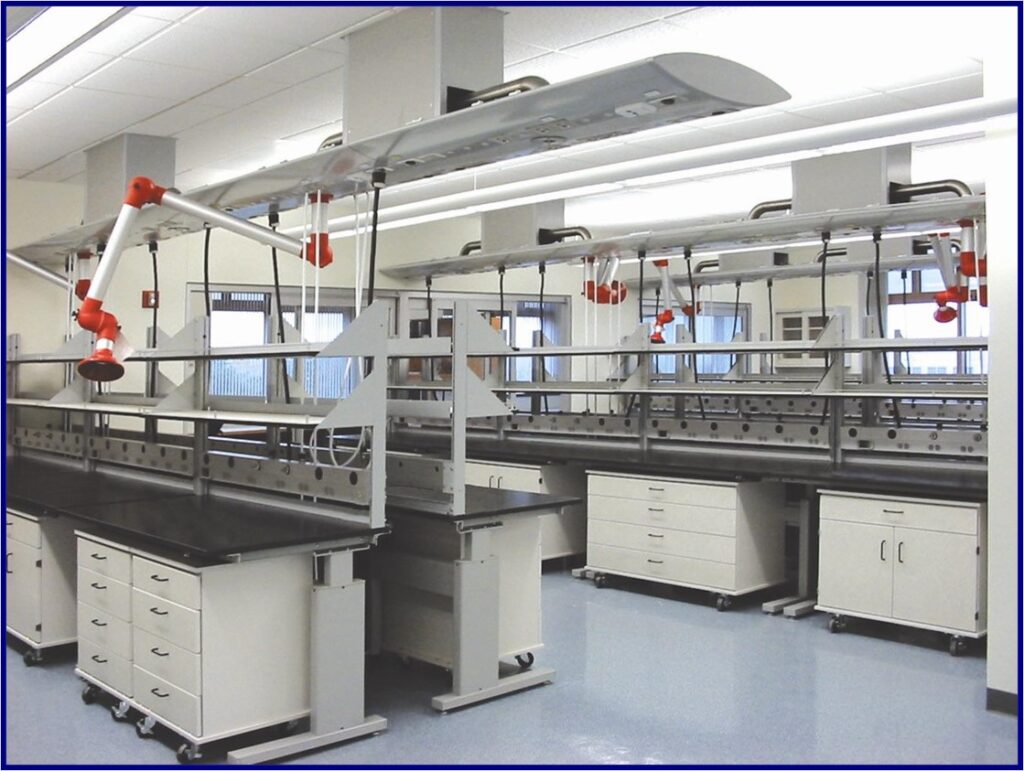The materials used in laboratory casework are crucial, as they directly impact the durability, functionality, safety, and aesthetics of your fixtures. While specific requirements vary based on each laboratory’s needs, what follows is a summary of the most used materials in the construction of laboratory casework.

Stainless Steel: The Workhorse of Laboratory Casework:
Stainless steel has long been a preferred material in casework manufacturing, due to its exceptional durability, its corrosion resistance, and ease of cleaning. Stainless Steel can withstand exposure to various chemicals, moisture, and elevated temperatures, making it suitable for demanding lab environments.
High-Density Polyethylene (HDPE): A Versatile Choice:
HDPE has gained traction as an alternative material for laboratory casework due to its exceptional chemical resistance, its impact strength, and low moisture absorption. HDPE is resistant to acids, bases, and solvents, making it ideal for laboratories managing corrosive substances. It is also lightweight and easy to fabricate, allowing for custom designs.
Epoxy Resin: The Ideal Surface for Laboratory Work:
Epoxy resin is widely used for laboratory countertops and work surfaces due to its exceptional chemical resistance, its non-porous properties, and its exceptional durability. Epoxy resin countertops are resistant to acids, bases, and solvents. They are also heat-resistant and easy to clean.
Phenolic resin: Durable and Chemical-Resistant
Phenolic resin is another durable material used in laboratory casework. A synthetic polymer derived from the reaction of phenol with formaldehyde, phenolic resin provides excellent chemical resistance, especially to acids and solvents. It is also impact resistant, heat resistant, non-porous, and affordable.
Glass: Combining Aesthetics and Functionality:
Glass elements in laboratory casework offer a blend of aesthetics, visibility, and durability. Borosilicate glass, which contains boron trioxide, and tempered glass are both designed to resist cracking under extreme temperature, whereas laminated glass provides safety by holding the glass together after it has shattered. Both are used for cabinet doors, windows, and viewing panels in laboratory casework.
Wood Laminates: Aesthetic Appeal and Cost-Effectiveness
Wood laminates are an option for casework where aesthetics and cost-effectiveness are prioritized. Wood laminates can provide a warm and natural look to a laboratory environment, but it is important to choose laminates that have good chemical resistance and are properly sealed to protect against moisture and damage.
Melamine: Budget-Friendly and Versatile
Melamine is a budget-friendly material used for laboratory casework. It is made by applying a melamine resin coating to a substrate, usually particleboard or MDF (medium-density fiberboard). Melamine offers moderate chemical resistance and is available in a variety of colors and finishes.
Other advancements in Materials Science:
The field of materials science is continuously evolving, and new materials are being developed to meet the changing demands of laboratory casework. This includes materials with enhanced chemical resistance, antimicrobial properties, fire resistance, and acoustical control. It also includes Smart Materials and IoT Integration, casework with nanotechnology applications and those made of sustainable materials.
Conclusion:
Materials science plays a vital role in the manufacturing process of laboratory casework, ensuring that these fixtures meet the demanding requirements of scientific research environments. From stainless steel to HDPE, epoxy resin to glass, the selection and application of materials contribute to the durability, functionality, and safety of laboratory casework. As materials science continues to advance, we can expect even more innovative solutions to emerge, further enhancing the capabilities of laboratory workspaces.
